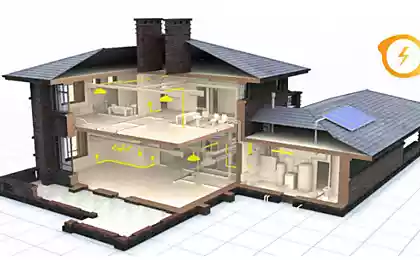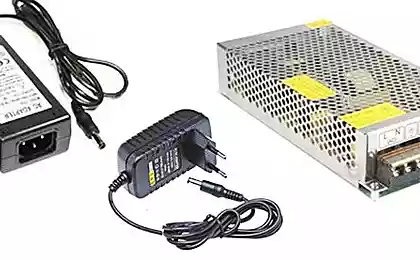595
What to consider when choosing an uninterruptible power supply
The UPS is an important element when building complex systems, where the need to guarantee security against unexpected power outages and other problems in the electrical system. Will look at which criteria should be considered when choosing a UPS.
Now the market is crowded with many different devices like price tag and quality. Understand all this variety is incredibly difficult. If your budget is limited, you need to approach the choice with maximum responsibility. So to start is to ask yourself a few questions:
— How important equipment you are going to protect?
— What time of Autonomous operation of equipment in case of loss of tension would be optimal?
In order to answer these questions is to understand what classes UPS now exist, and to determine the basic criteria that must be considered when choosing a UPS.
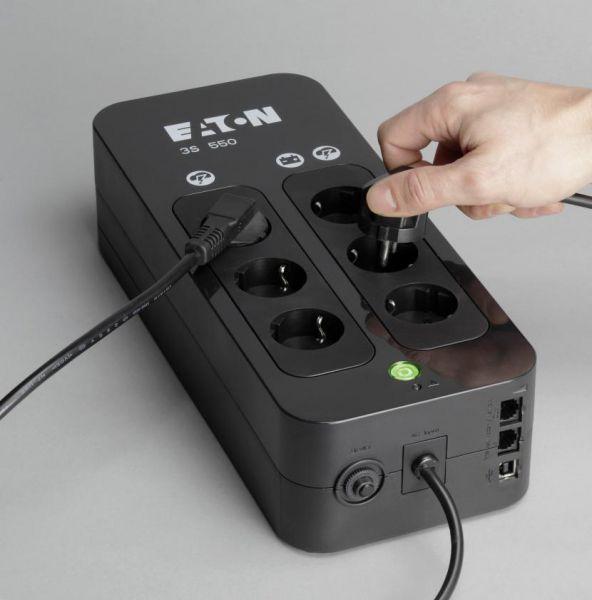
Classes UPSClasses on the market UPS differ from other behavior in different modes of operation and schematics. Release:
As a backup or off-line UPS (BackUp),
— Line-interactive UPS (Line-interactive),
— The UPS with double conversion (on-line, double-conversion).
Off-Line UPS is considered the most simple and unpretentious. In the normal mode of operation electricity is supplied to the input of such a “battery backup, and after the transit is supplied to the main load. If you experience network problems (drops and voltage drop), the UPS automatically switches to battery operation.
The disadvantages of this scheme of work is a long — term switching power to the batteries (from 4 to 10 milliseconds). In addition when the UPS battery on the equipment is not usual for sine, approximated sine.
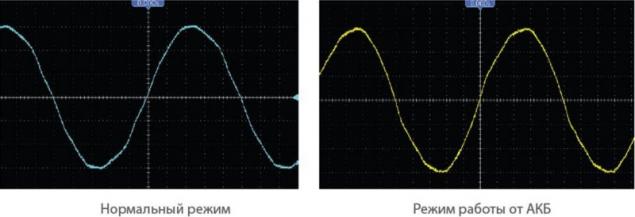
The following class of uninterruptible power supplies Line-interactive has no fundamental differences from the circuit Off-line. In the event of a crash diet also switches on the battery and spent on this is similar (from 4 to 10 milliseconds). The output is also obtained an approximated sine.
However, the UPS in this class at the entrance there is a transformer, which helped to compensate for those voltage drops. It is worth emphasizing that the UPS class Off-line and Line-interactive is not intended for connection of critical equipment.

When you connect critical equipment, it is recommended to use the UPS with double conversion (double conversion) or On-line UPS. The work of such uninterruptible power supplies are arranged so that the input voltage is corrected because of the rectifier. The inverter then converts DC voltage to AC. In this arrangement, the battery is connected to the output of the rectifier and the inverter, allowing the transition (0 milliseconds) to the battery.

PowerOne of the most important parameters on which you should pay attention to when choosing a UPS is the power of the connected equipment. Underestimation of this factor can lead to very disastrous results — UPS may not be able to cope with the load in the event of an accident. Ineffective will a UPS whose power exceeds the required by the load.
Power applied to the uninterruptible power supply can be divided into:
— Full power — this is the sum of active and reactive power, as well as the deviation from the shape of current and voltage from a sine wave.
— Active power is the energy that takes away the load from the source of energy for further conversion of useful energy.
To determine the power UPS, you need to know the power factor of the connected equipment. In other words, the ratio of active power to total
Usually, in the specifications indicate the UPS input and output power factors. Input indicates the behavior of the UPS compared to the electrical network. A very important factor of the output power, because it shows the power received by the load
To calculate power UPS that will be necessary to ensure the load you need to consider the sum of the rated consumption of the equipment and load during startup. When et's not forget about the power reserve of 25%, that is, the Power UPS should be 25% higher power equipment.
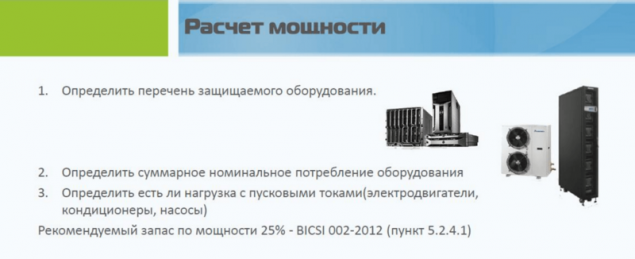
The efficiencyto Determine the efficiency of the uninterruptible power supply is very important because this is the main indicator of efficiency of its use. Inefficient work of the UPS leads to unreasonable costs.
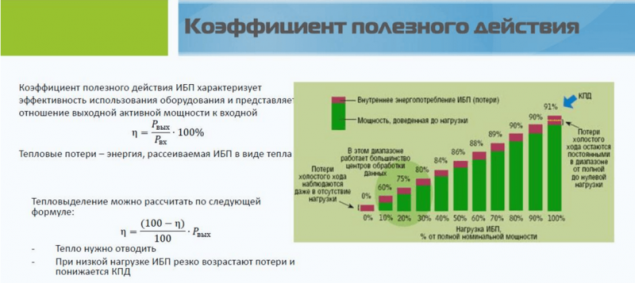
In addition to this efficiency determines the amount of heat in the environment highlights the UPS. This figure is important when designing a server. For example, if the UPS will be installed with a small capacity, it will not be a lot of heat. On the contrary, at high power “battery backup” is several tens of kilowatts, and the dissipation will be large. To avoid overheating of the equipment will have some way to remove heat from the premises, and this additional spending on power conditioning. The result is that the greater the efficiency, the less heat will be allocated.
As an example, we present some options for effective and ineffective use of UPS:
— In the first case, to the UPS power 800 Watt connected equipment with a capacity of 50 Watts. The self-sufficiency UPS uses about 70 Watts. Counting efficiency according to the formula and get 42%.
In the second case, when the same load is 600 W, the efficiency will be much higher — 89%. This option is more preferable and effective.
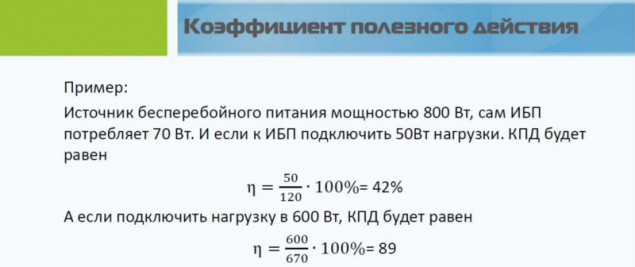
The battery lifeTime of UPS Autonomous operation is the time that the UPS can maintain operation of equipment in case of emergency in the power grid. The battery life mostly depends on the condition of the battery and power consumption.
When the network issues it is only important to correctly shut down the equipment in a short period of time, it is your choice, you can stop the UPS with integrated batteries.
If there is a need for a much greater time of operation of the equipment, it is necessary to calculate the required discharge current of the battery. To calculate this indicator has a special formula:
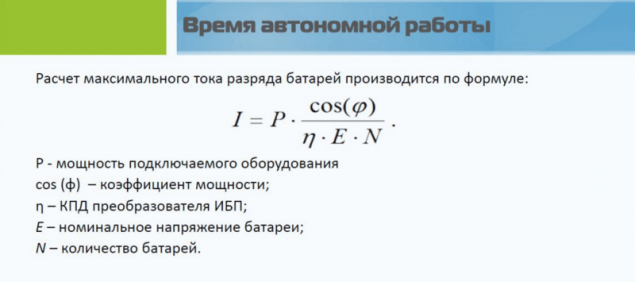
published
P. S. And remember, only by changing their consumption — together we change the world! ©
Source: //geektimes.ru/company/nag/blog/287962/
Now the market is crowded with many different devices like price tag and quality. Understand all this variety is incredibly difficult. If your budget is limited, you need to approach the choice with maximum responsibility. So to start is to ask yourself a few questions:
— How important equipment you are going to protect?
— What time of Autonomous operation of equipment in case of loss of tension would be optimal?
In order to answer these questions is to understand what classes UPS now exist, and to determine the basic criteria that must be considered when choosing a UPS.

Classes UPSClasses on the market UPS differ from other behavior in different modes of operation and schematics. Release:
As a backup or off-line UPS (BackUp),
— Line-interactive UPS (Line-interactive),
— The UPS with double conversion (on-line, double-conversion).
Off-Line UPS is considered the most simple and unpretentious. In the normal mode of operation electricity is supplied to the input of such a “battery backup, and after the transit is supplied to the main load. If you experience network problems (drops and voltage drop), the UPS automatically switches to battery operation.
The disadvantages of this scheme of work is a long — term switching power to the batteries (from 4 to 10 milliseconds). In addition when the UPS battery on the equipment is not usual for sine, approximated sine.

The following class of uninterruptible power supplies Line-interactive has no fundamental differences from the circuit Off-line. In the event of a crash diet also switches on the battery and spent on this is similar (from 4 to 10 milliseconds). The output is also obtained an approximated sine.
However, the UPS in this class at the entrance there is a transformer, which helped to compensate for those voltage drops. It is worth emphasizing that the UPS class Off-line and Line-interactive is not intended for connection of critical equipment.

When you connect critical equipment, it is recommended to use the UPS with double conversion (double conversion) or On-line UPS. The work of such uninterruptible power supplies are arranged so that the input voltage is corrected because of the rectifier. The inverter then converts DC voltage to AC. In this arrangement, the battery is connected to the output of the rectifier and the inverter, allowing the transition (0 milliseconds) to the battery.

PowerOne of the most important parameters on which you should pay attention to when choosing a UPS is the power of the connected equipment. Underestimation of this factor can lead to very disastrous results — UPS may not be able to cope with the load in the event of an accident. Ineffective will a UPS whose power exceeds the required by the load.
Power applied to the uninterruptible power supply can be divided into:
— Full power — this is the sum of active and reactive power, as well as the deviation from the shape of current and voltage from a sine wave.
— Active power is the energy that takes away the load from the source of energy for further conversion of useful energy.
To determine the power UPS, you need to know the power factor of the connected equipment. In other words, the ratio of active power to total
Usually, in the specifications indicate the UPS input and output power factors. Input indicates the behavior of the UPS compared to the electrical network. A very important factor of the output power, because it shows the power received by the load
To calculate power UPS that will be necessary to ensure the load you need to consider the sum of the rated consumption of the equipment and load during startup. When et's not forget about the power reserve of 25%, that is, the Power UPS should be 25% higher power equipment.

The efficiencyto Determine the efficiency of the uninterruptible power supply is very important because this is the main indicator of efficiency of its use. Inefficient work of the UPS leads to unreasonable costs.

In addition to this efficiency determines the amount of heat in the environment highlights the UPS. This figure is important when designing a server. For example, if the UPS will be installed with a small capacity, it will not be a lot of heat. On the contrary, at high power “battery backup” is several tens of kilowatts, and the dissipation will be large. To avoid overheating of the equipment will have some way to remove heat from the premises, and this additional spending on power conditioning. The result is that the greater the efficiency, the less heat will be allocated.
As an example, we present some options for effective and ineffective use of UPS:
— In the first case, to the UPS power 800 Watt connected equipment with a capacity of 50 Watts. The self-sufficiency UPS uses about 70 Watts. Counting efficiency according to the formula and get 42%.
In the second case, when the same load is 600 W, the efficiency will be much higher — 89%. This option is more preferable and effective.

The battery lifeTime of UPS Autonomous operation is the time that the UPS can maintain operation of equipment in case of emergency in the power grid. The battery life mostly depends on the condition of the battery and power consumption.
When the network issues it is only important to correctly shut down the equipment in a short period of time, it is your choice, you can stop the UPS with integrated batteries.
If there is a need for a much greater time of operation of the equipment, it is necessary to calculate the required discharge current of the battery. To calculate this indicator has a special formula:

published
P. S. And remember, only by changing their consumption — together we change the world! ©
Source: //geektimes.ru/company/nag/blog/287962/



